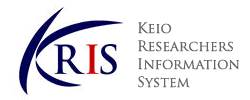-
Affiliation
-
Faculty of Science and Technology, Department of System Design Engineering ( Yagami )
-
Position
-
Professor
-
Related Websites

KEIO RESEARCHERS INFORMATION SYSTEM |
Details of a Researcher
このページはJavascriptを使用しています。すべての機能を使用するためにはJavascript を有効にする必要があります。
Nishi, Hiroaki
|
|
|
Real World Computing Partnership
Hitachi, Ltd., Central Research Laboratory
大学助手(有期)(理工学部システムデザイン工学科)
専任講師(理工学部システムデザイン工学科)
National Institute of Informatics, Invited Associate Professor
Keio University, Faculty of Science and Engineering, 電気工学科
University, Graduated
Keio University, Graduate School, Division of Science and Engineering, 計算機科学専攻
Graduate School, Completed, Master's course
Keio University, Graduate School, Division of Science and Engineering, 計算機科学専攻
Graduate School, Withdrawal after completion of doctoral course requirements, Doctoral course
Manufacturing Technology (Mechanical Engineering, Electrical and Electronic Engineering, Chemical Engineering) / Communication and network engineering (Communication/Network Engineering)
Social Infrastructure (Civil Engineering, Architecture, Disaster Prevention) / Social systems engineering
Social Infrastructure (Civil Engineering, Architecture, Disaster Prevention) / Safety engineering
Informatics / Computer system (Computer System Network)
ASIC / CPLD design
Community/Cluster Energy Management System
Smart City / Smart Community
Internet backbone router
Internet backbone router or switch architecture
地球とつながる暮らしのデザイン
NISHI HIROAKIet al, 株式会社シナノ, 2016.05
Scope: 家のエネルギーの使い方のシンフォニー(pp.227-232)
Smart Grid Research: Vehicular - IEEE Smart Grid Vision for Vehicular Technology: 2030 and Beyond Roadmap
Hiroaki Nishi, Koichi Inoue, IEEE Standards Committee, 2015.06
Anonymization infrastructure and open data in smart sustainable cities
Jie Chang, Lei Gu, Wei Liu, Kanae Matsui, Hiroaki Nishi and Cuijuan Xia, Approved Deliverable of ITU-T (Telecommunicatino Standardization Section of ITU) Focus Group on Smart Sustainable Cities, 2015.04
スマートメータ―からの情報をどう匿名化するか-電力自由化時代の個人情報の活用法- 『インプレス SmartGrid ニューズレター』2014年7月号
NISHI HIROAKI, 株式会社インプレス, 2014.07
pvFed: Personalized Vertical Federated learning for Client-Specific Tasks
Akihito Nishikawa, Tomu Yanabe, Yuiko Sakuma, Yuma Okuda, Hiroaki Nishi
IEEJ Transactions on Electrical and Electronic Engineering (IEEJ Transactions on Electrical and Electronic Engineering) 19 ( 6 ) 993 - 1000 2024.06
ISSN 19314973
FPGA Live Migration of Content-Based Anonymization Mechanism with Network Consistency
Toyohara, T., Yamamoto, K., Nishi, H.
IEEJ Transactions on Electrical and Electronic Engineering (IEEJ Transactions on Electrical and Electronic Engineering) 19 ( 4 ) 507 - 517 2024.04
ISSN 19314973
Yohei Namba, Shogo Shimahara, Hiroaki Nishi
ICSIM 23 - 28 2024.01
Anonymity‐Aware Framework for Designing Recommender Systems
M Honda, H Nishi
IEEJ Transactions on Electrical and Electronic Engineering 2024
マルチチャンネル音源を使用した異常音検知・分離・音源同定手法の提案と大型冷凍機を用いた評価
Nishi, Hiroaki
AICカンファレンス予稿集 (慶應義塾大学AI・高度プログラミングコンソーシアム) 59 - 59 2023
Smart community information platform for providing critical services
Nishi, Hiroaki
科学研究費補助金研究成果報告書 2019
Broadcast responsive vibration control system to reduce damage to facilities
Nishi, Hiroaki
科学研究費補助金研究成果報告書 2019
Imprementation and deployment of content-based smart community infrastructure
Nishi, Hiroaki
科学研究費補助金研究成果報告書 2015
Sustainable energy consumption
C Ramos, Z Vale, P Palensky, H Nishi
Energies 14 (20), 6665 (Energies) 14 ( 20 ) 2021.10
ISSN 19961073
Nishi H.
ACM International Conference Proceeding Series (ACM International Conference Proceeding Series) VII - VIII 2021.01
ISSN 9781450388955
Resilient Vibration Control Method Considering Functional Continuity and Rapid Restoration
Grants-in-Aid for Scientific Research, Grant-in-Aid for Scientific Research (B), No Setting
Smart Community Information Platform for Providing Critical Services
MEXT,JSPS, Grant-in-Aid for Scientific Research, NISHI HIROAKI, Grant-in-Aid for Scientific Research (B), Principal investigator
Broadcast Responsive Vibration Control System to Reduce Damage to Facilities
Grants-in-Aid for Scientific Research, Kohiyama Masayuki, Grant-in-Aid for Scientific Research (B), No Setting
電力制御システム
Date applied: 2010-108910 2010.05
Patent, Joint
人数推定装置及び人数推定方法
Date applied: 特願2009-292481 2009.12
Patent, Joint
換気量推定装置及び換気量推定方法
Date applied: 特願2008-180072 2008.07
Patent, Joint
マニピュレーター装置
Date applied: 2007-103550 2007.04
Date announced: 2008-259607
Patent, Joint
マスタスレーブ装置、マスタ装置、スレーブ装置、制御方法及びコンピュータプログラム
Date applied: 特願:2006-302787 2006.11
Patent, Joint
社団法人情報処理学会 計算機アーキテクチャ研究会若手奨励賞
澤田 純一,西 宏章, 2012.01, 社団法人情報処理学会計算機アーキテクチャ研究会, 「低遅延匿名化処理機構における情報損失度改善手法の提案」
Type of Award: Award from Japanese society, conference, symposium, etc.
社団法人情報処理学会CS賞
石田慎一, 原島真悟, 鯉渕道紘, 川島英之, #H西宏章, 2011.07, 社団法人情報処理学会, 「コンテキストスイッチを利用したルータにおけるTCP ストリーム再構築のメモリ削減手法」
Type of Award: Award from Japanese society, conference, symposium, etc.
第144回SLDM研究会優秀発表学生賞
石田慎一, 原島真悟, 川島英之, 鯉渕道紘, 西 宏章, 2010.09, 社団法人情報処理学会システムLSI設計技術研究会, 「パケットデータ管理基盤における情報抽出処理の効率化技法」
Type of Award: Award from Japanese society, conference, symposium, etc.
社団法人情報処理学会ユビキタスコンピューティング研究会優秀論文賞
上吉 悠人,峰 豪毅,西 宏章, 2008.07, 「クラスタ型エネルギーマネジメントに向けた大学キャンパスのエネルギー計測システム」
Type of Award: Award from Japanese society, conference, symposium, etc.
財団法人ファナックFAロボット財団論文賞
水落 麻里子,辻 俊明,大西 公平,西 宏章, 2008.03, マルチレートサンプリング手法を用いた加速度制御系の実現
Type of Award: Award from publisher, newspaper, foundation, etc.
SEMINAR IN SYSTEM DESIGN ENGINEERING
2025
MULTI-MEDIA SYSTEMS DESIGN
2025
MACHINE LEARNING SYSTEM DESIGN
2025
LABORATORIES IN SYSTEM DESIGN ENGINEERING 2)
2025
INDEPENDENT STUDY ON SCIENCE FOR OPEN AND ENVIRONMENTAL SYSTEMS
2025
一般社団法人 おもてなしICT協議会 代表理事
CANDER TPC member
総務省「本格的なIoT時代に対応した情報通信技術の研究開発・標準化動向及びその推進のための調査・分析」事業における「IoT利活用のための共通ICT基盤の研究開発・標準化動向の調査検討グループ」グループ長
FPGA4GPC Program Committee Member
NEDO ノーマリーオフコンピューティングの普及検討委員会 委員
電信通信情報学会シニア会員,
情報処理学会計算機アーキテクチャ研究会,
建築学会,
電子情報通信学会コンピュータシステム研究専門委員会,
計測自動制御学会,
IEEE 2668 (IDEX) Standards Committee Member, IEEE 2668 (IDEX) Standards Committee Member
IEEE P21451-1-6 Standards Committee Member, IEEE P21451-1-6 Standards Committee Member
IEEE P1451.0 Standards Committee Member, IEEE P1451.0 Standards Committee Member
IEEE P1451-99 Standards Committee Member, IEEE P1451-99 Standards Committee Member
Urban Technology Alliance, Urban Technology Alliance